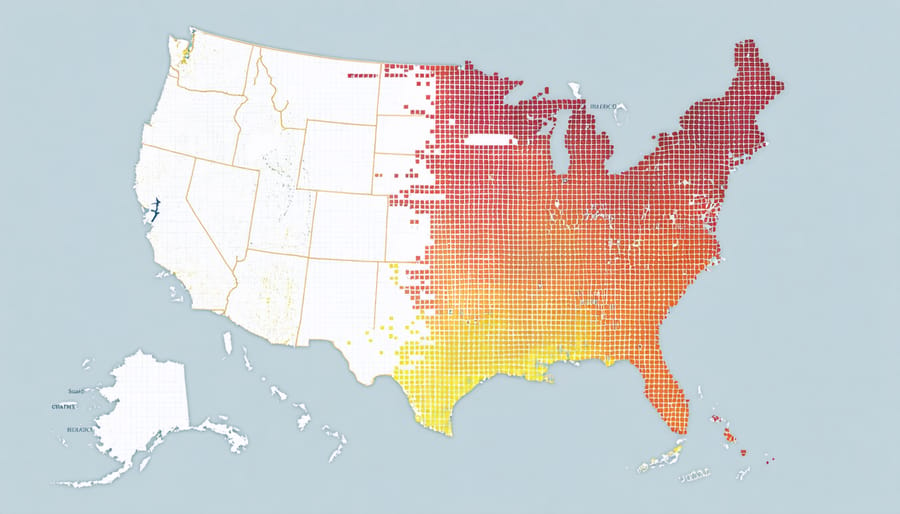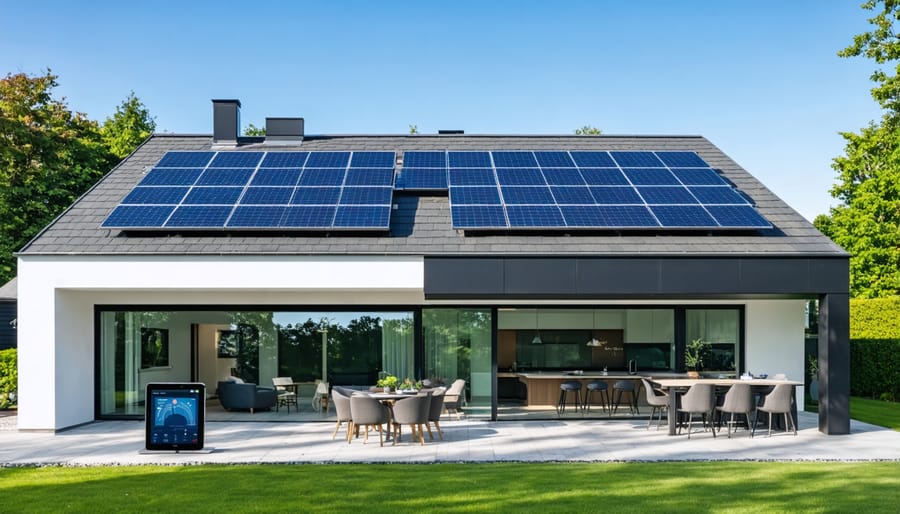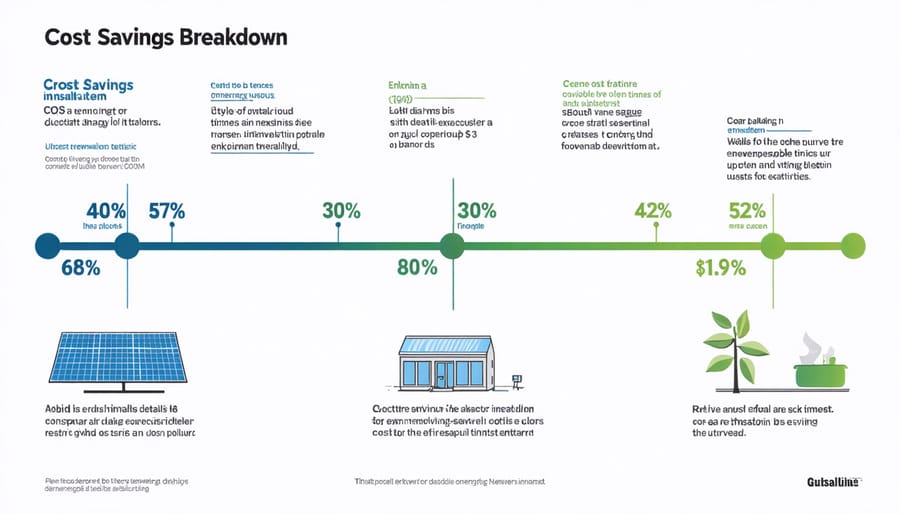Discover your home’s renewable energy potential with our interactive U.S. renewable energy map, your gateway to sustainable living and reduced utility bills. Whether you’re considering solar panels, wind energy, or geothermal systems, understanding your region’s renewable resources is the first step to transform your house into an energy-saving powerhouse. Our comprehensive map highlights solar intensity zones, wind power corridors, and geothermal hotspots across America, helping you make informed decisions about the most effective renewable solutions for your specific location.
From sun-drenched Arizona to the windswept plains of Texas, each region offers unique opportunities for clean energy adoption. This user-friendly tool combines detailed climate data, state incentives, and installation requirements, making it simple to evaluate your property’s renewable energy potential. Whether you’re a first-time homeowner or looking to upgrade your existing system, our map provides the essential insights you need to start your sustainable energy journey.
Understanding Your Region’s Renewable Energy Potential

Solar Energy Hotspots
The sun’s power isn’t equal everywhere in the United States, and knowing your region’s solar potential can help you make smart energy decisions. The Southwest, particularly Arizona, Nevada, and New Mexico, leads the pack with over 300 sunny days per year, making these states prime spots for solar energy harvesting.
California’s diverse landscape offers excellent solar opportunities, especially in its sun-drenched southern regions. The state’s combination of favorable policies and abundant sunshine has made it a national leader in solar adoption. Even coastal areas, despite morning fog, receive plenty of sunlight for effective solar power generation.
Don’t count out the Southeast! States like Florida, Georgia, and South Carolina benefit from long summer days and moderate winters, creating year-round solar potential. While the Northeast experiences fewer sunny days, states like Massachusetts and New York have proven that solar can still be highly effective, especially during peak summer months.
The Midwest presents a surprising opportunity for solar energy. States like Minnesota and Illinois receive ample sunshine during warmer months, and modern solar technology has evolved to perform well even in cooler climates. Mountain states like Colorado combine high altitude with clear skies, creating excellent conditions for solar power despite cooler temperatures.
Remember, even areas with less direct sunlight can benefit from solar installations – it’s all about proper planning and positioning of your panels.
Wind Power Zones
When it comes to harnessing wind power for your home, location is everything. The United States boasts several prime wind energy zones, with the Great Plains region, often called “America’s Wind Belt,” leading the pack. This area, stretching from Texas to North Dakota, experiences consistent, strong winds that make it ideal for both large-scale and residential wind power systems.
Coastal areas, particularly along the Atlantic seaboard and Pacific Northwest, also offer excellent wind energy potential. These regions benefit from steady sea breezes and thermal winds that can power residential turbines effectively. The New England coast, for instance, sees some of the highest average wind speeds in the country, making it particularly suitable for home wind energy systems.
Mountain regions and elevated areas across the country present another opportunity for wind power. States like Colorado, Wyoming, and Montana feature numerous zones where wind conditions are perfect for residential turbines. Even in areas with moderate wind speeds, modern small-scale wind turbines can still generate significant power for your home.
Before installing a wind system, it’s crucial to conduct a site assessment. Local wind maps and data from nearby weather stations can help determine if your specific location has sufficient wind resources. Remember that even small variations in local topography, like hills or large buildings, can significantly impact wind patterns at your property.
Most residential wind systems require average wind speeds of at least 10 miles per hour to be effective, though newer technologies are making it possible to generate power with even lighter winds.
Smart Home Integration Solutions
Solar Panel Placement and Design
When it comes to solar panel placement, finding the sweet spot between aesthetics and efficiency is key to maximizing your home’s renewable energy potential. Start by evaluating your roof’s orientation – south-facing surfaces typically receive the most sunlight throughout the day in the United States. However, east and west-facing installations can still be viable options, especially if you’re looking to capture morning or afternoon sun.
Consider the visual impact of your panels by matching them with your roof’s color scheme. Modern solar panels come in various styles, including sleek black modules that blend seamlessly with darker roofing materials. For a cohesive look, try arranging panels in a rectangular grid pattern that follows your roof’s lines.
Don’t forget about shade factors when planning placement. Trees, chimneys, and nearby buildings can affect panel performance. A good rule of thumb is to ensure panels receive unobstructed sunlight between 9 AM and 3 PM. Consider seasonal changes too – what might be a sunny spot in summer could be shaded in winter.
For flat roofs, mounting systems can be angled optimally without being visible from street level. If roof installation isn’t ideal, ground-mounted systems or solar pergolas offer creative alternatives that can double as landscape features. Some homeowners are even incorporating solar panels into garden structures or carports for a dual-purpose design approach.
Remember to check local regulations and HOA guidelines before finalizing your design. Many areas now have solar access laws protecting your right to install panels, but specific aesthetic requirements may still apply. Working with a certified installer can help ensure your system looks great while performing at its best.

Energy Storage Solutions
Energy storage is becoming a game-changer in how we harness and use renewable energy at home. As more households embrace solar panels and wind energy, the need for reliable storage solutions has never been more important. Modern battery systems, particularly lithium-ion batteries, are revolutionizing how we store and manage our renewable energy resources.
The integration of smart energy solutions with storage systems allows homeowners to maximize their energy independence. These systems can automatically store excess energy during peak production times and release it when needed, such as during cloudy days or at night. Think of it as having your personal energy bank account – you save when there’s plenty and withdraw when necessary.
Modern storage solutions come in various sizes to suit different household needs. A typical home battery system can store anywhere from 10 to 15 kilowatt-hours of energy, enough to power most homes through the evening hours. The best part? These systems are becoming more compact and aesthetically pleasing, fitting nicely into your garage or utility room without being an eyesore.
Smart power management systems take storage efficiency to the next level. They learn your household’s energy usage patterns and automatically optimize storage and consumption. For example, they might store more energy when weather forecasts predict cloudy days ahead or adjust charging cycles to take advantage of lower utility rates during off-peak hours.
When choosing a storage solution, consider your home’s energy needs, available space, and local climate conditions. Many systems are now designed for easy expansion, allowing you to start small and scale up as your needs grow.

Cost Benefits and Incentives
Federal Tax Credits
Looking to make your home more sustainable? The federal government offers substantial tax credits to help homeowners embrace renewable energy solutions. As of 2024, you can claim up to 30% of the total cost for installing solar panels, wind turbines, and geothermal heat pumps through the Residential Clean Energy Credit. This incentive makes energy-smart home upgrades more affordable than ever before.
The credit covers not just the equipment but also installation costs, and there’s no upper limit on the amount you can claim. For solar installations, this includes panels, inverters, wiring, and professional labor. Wind energy systems under 100 kilowatts qualify for the same 30% credit, perfect for properties with ample space and good wind resources.
Battery storage systems now qualify for the credit too, even when installed separately from solar panels. This means you can add energy storage to your existing setup and still receive the tax benefit. The credit will remain at 30% through 2032, then step down to 26% in 2033 and 22% in 2034.
Remember, these credits are non-refundable but can be carried forward to future tax years if you can’t use the full amount immediately. Always consult with a tax professional to maximize your benefits and ensure proper documentation of your renewable energy investments.
State-Specific Programs
Each state offers unique incentives and programs to help homeowners embrace renewable energy. California leads the way with its Solar Initiative and generous rebates, making solar installations more affordable for residents. In the Northeast, Massachusetts and New York provide substantial tax credits and performance-based incentives for both solar and wind energy systems.
Texas, despite being known for oil, has become a wind energy powerhouse, offering various programs to support residential wind turbine installations. Meanwhile, Hawaii’s Smart Export and Customer Grid Supply Plus programs make it easier for homeowners to integrate solar systems with battery storage.
Some states have particularly innovative approaches. Oregon’s Solar + Storage Rebate Program combines traditional solar incentives with battery storage support, while Minnesota’s Solar*Rewards program offers production-based incentives that pay you for the energy you generate.
Don’t forget to check your local utility companies too – many offer additional rebates and incentives beyond state programs. For example, Arizona utilities frequently provide peak demand reduction rewards for homes with smart energy storage systems.
Remember that these programs change regularly, so it’s worth consulting your local energy office or a qualified renewable energy installer to learn about current offerings in your area. Many states also provide special financing options, like Property Assessed Clean Energy (PACE) programs, making renewable energy upgrades more accessible to homeowners.
Design Tips for Maximum Efficiency
When it comes to maximizing renewable energy efficiency in your home, thoughtful design plays a crucial role in helping you create your dream eco-friendly home. Let’s explore both interior and exterior considerations that can make a significant difference in your energy setup.
For the exterior, start by evaluating your roof orientation and angle. South-facing roofs with a 30-45 degree pitch typically offer optimal conditions for solar panels in most U.S. locations. Consider trimming tall trees that might cast shadows on your panels, but don’t remove them completely – strategic landscaping can actually help with natural cooling.
When it comes to interior design, focus on maximizing natural light while maintaining temperature control. Position large windows on the south side of your home to capture winter sun, but incorporate adjustable shading solutions like retractable awnings or deciduous trees to prevent overheating in summer.
Think about your room layout with energy efficiency in mind. Place frequently used spaces like living rooms and home offices where they can benefit from natural light and passive solar heating. Consider open-plan layouts to improve air circulation and heat distribution throughout your home.
Color choices matter too! Opt for lighter colors on your walls and ceilings to reflect natural light and reduce the need for artificial lighting. In warmer regions, choose cool-toned exterior paint colors to reflect heat, while darker tones in cooler climates can help absorb warmth.
Storage solutions should be integrated thoughtfully to accommodate renewable energy components. Design dedicated spaces for batteries if you’re planning a solar setup, ensuring they’re easily accessible but out of sight. Consider creating a utility room that houses your inverter and monitoring systems while maintaining your home’s aesthetic appeal.
Don’t forget about smart technology integration. Plan for strategic placement of smart thermostats and energy monitoring displays where they’re easily visible but don’t clash with your décor. Include plenty of charging stations and USB ports powered by your renewable energy system, particularly in home offices and common areas.
Remember that good design isn’t just about aesthetics – it’s about creating spaces that work efficiently while looking beautiful. By considering these design elements early in your renewable energy planning, you’ll achieve better results and a more harmonious living environment.
Understanding your region’s renewable energy potential is the first step toward a more sustainable home. As we’ve explored, the U.S. offers diverse opportunities for solar, wind, and other clean energy sources, with each area presenting unique advantages. Whether you’re in the sun-drenched Southwest or the wind-rich Plains, there’s a renewable solution that can work for your home.
Start by reaching out to local renewable energy installers for a property assessment. They can help you understand which options are best suited for your location and energy needs. Consider joining community solar programs if rooftop installation isn’t feasible, and don’t forget to check for state and federal incentives that can make your transition more affordable.
Remember, embracing renewable energy isn’t just about reducing your carbon footprint – it’s an investment in your home’s future value and energy independence. Take that first step today, and be part of America’s clean energy transformation.